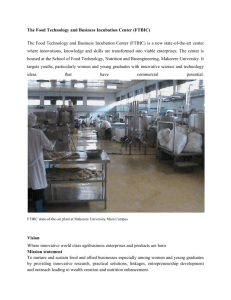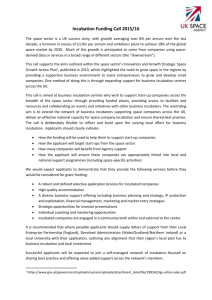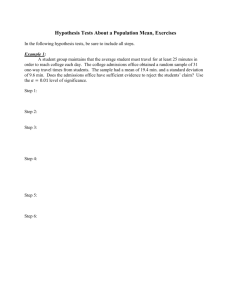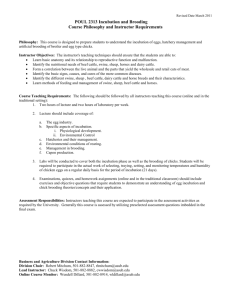eAppendix
advertisement
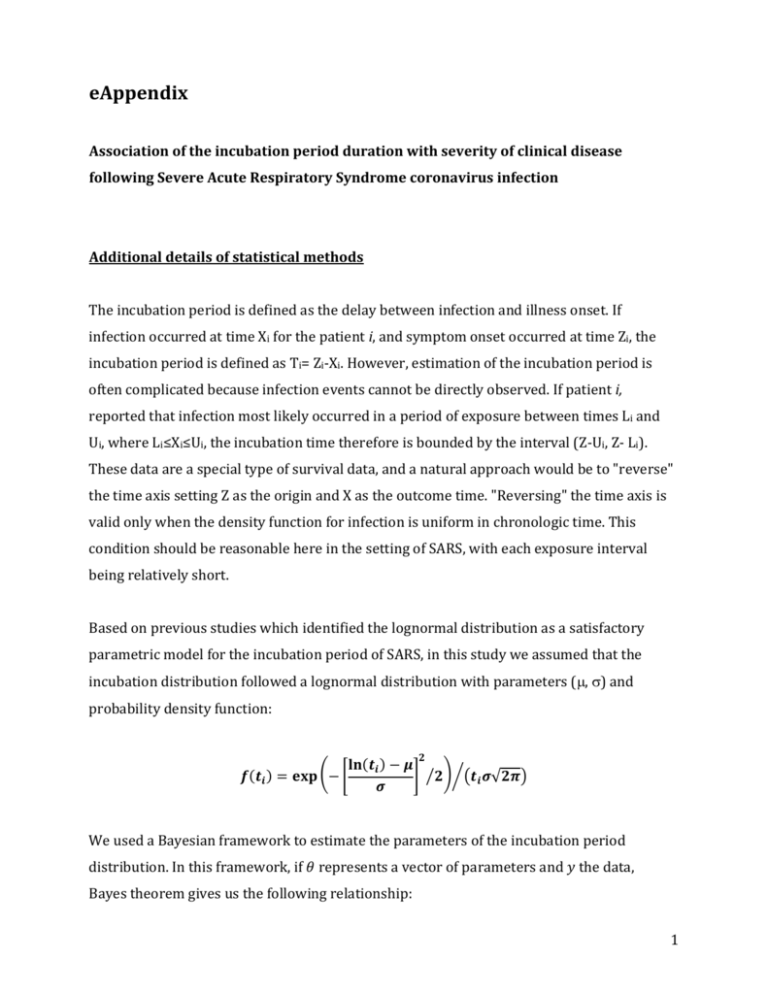
eAppendix Association of the incubation period duration with severity of clinical disease following Severe Acute Respiratory Syndrome coronavirus infection Additional details of statistical methods The incubation period is defined as the delay between infection and illness onset. If infection occurred at time Xi for the patient i, and symptom onset occurred at time Zi, the incubation period is defined as Ti= Zi-Xi. However, estimation of the incubation period is often complicated because infection events cannot be directly observed. If patient i, reported that infection most likely occurred in a period of exposure between times Li and Ui, where Li≤Xi≤Ui, the incubation time therefore is bounded by the interval (Z-Ui, Z- Li). These data are a special type of survival data, and a natural approach would be to "reverse" the time axis setting Z as the origin and X as the outcome time. "Reversing" the time axis is valid only when the density function for infection is uniform in chronologic time. This condition should be reasonable here in the setting of SARS, with each exposure interval being relatively short. Based on previous studies which identified the lognormal distribution as a satisfactory parametric model for the incubation period of SARS, in this study we assumed that the incubation distribution followed a lognormal distribution with parameters (, ) and probability density function: 𝟐 𝐥𝐧(𝒕𝒊 ) − 𝝁 𝒇(𝒕𝒊 ) = 𝐞𝐱𝐩 (− [ ] ⁄𝟐)⁄(𝒕𝒊 𝝈√𝟐𝝅) 𝝈 We used a Bayesian framework to estimate the parameters of the incubation period distribution. In this framework, if 𝜃 represents a vector of parameters and 𝑦 the data, Bayes theorem gives us the following relationship: 1 (1) 𝒑(𝒚|𝜽)𝒑(𝜽) 𝒑(𝜽|𝒚) = 𝒑(𝒚) where 𝑝(𝜃) is the prior probability of the parameters 𝜃 , 𝑝(𝑦|𝜃) is the likelihood function and 𝑝(𝜃|𝑦) is the posterior probability of 𝜃 given the data 𝑦. The MCMC process was initiated by giving random values to the parameters 𝜃 and by choosing non-informative prior (flat prior) for 𝜃. A Metropolis Hastings algorithm was used to update the parameter values in each iteration. In each iteration, all the 𝑘 parameters are 𝑗−1 randomly generated using the normal distribution with the mean 𝜃𝑘 𝑗−1 the kth parameter) and standard error 𝜎𝑘 , 𝑁(𝜃𝑘 (previous value of , 𝜎𝑘 ) for each parameter. The updated likelihood is compared with the previous one using the following accept-reject method: 𝒒= 𝒑(𝒚|𝜃 𝑗 )𝒑(𝜃 𝑗 ) 𝒑(𝒚|𝜃 𝑗−1 )𝒑(𝜃 𝑗−1 ) If 𝑞 ≥ 1, the proposed new values of parameters 𝜃 𝑗 are accepted If 𝑞 < 1, then 𝜃 𝑗 are accepted with probability 𝑞. A burn-in period with 5,000 iterations was used to reduce the bias of the choice of the initial parameter values and to generate values only in the stationary distribution. The above algorithm was repeated 10,000 times after the burn-in period, with an acceptance rate included in [0.45,0.55] for each parameter (adjusting on 𝜎𝑘 ). For interval-censored data the following 𝑝(𝑦|𝜃) was used: 𝒏 𝒑(𝒚|𝜽) = ∏ 𝑺(𝒖𝒊 |𝜽) − 𝑺(𝒍𝒊 |𝜽) 𝒊=𝟏 where [𝑢𝑖 , 𝑙𝑖 ] are the interval censored data of the patient i and S(.) is the survival lognormal distribution function. 2 Parameters of the fitted lognormal distribution In patients with exposure intervals data, the parameters of the lognormal distribution were estimated with the MCMC approach in the fatal and non-fatal cases, respectively. The estimates are for fatal cases: = 0.97 (95% CrI: 0.44, 1.38) and = 0.88 (95% CrI: 0.58, 1.34) and for non-fatal cases: = 1.24 (95% CrI: 1.09, 1.37) and = 0.88 (95% CrI: 0.58, 1.34). Among patients of the Amoy garden cohort, the parameters of the lognormal distribution were estimated with the same approach approach. The estimates are for fatal cases: = 1.37 (95% CrI: 1.19, 1.54) and = 0.54 (95% CrI: 0.43, 0.68) and for non-fatal cases: = 1.59 (95% CrI: 1.53, 1.65) and = 0.51 (95% CrI: 0.46, 0.55). Logistic regression model The logistic regression model used in this study is based on the following equation: 𝒑𝒊 𝒍𝒏 ( ) = 𝜷𝟎 + 𝜷𝟏 𝑿𝟏 (𝒊𝒏𝒄𝒖𝒃𝒂𝒕𝒊𝒐𝒏 𝒑𝒆𝒓𝒊𝒐𝒅) + 𝜷𝟐 𝑿𝟐 (𝒂𝒈𝒆) + 𝜷𝟑 𝑿𝟑 (𝒔𝒆𝒙) 𝟏 − 𝒑𝒊 + 𝜷𝟒 𝑿𝟒 (𝒐𝒄𝒄𝒖𝒑𝒂𝒕𝒊𝒐𝒏) where pi is the probability of death, i’s are the regression coefficients, estimated with MCMC (using flat priors N(0,100000)) and Xi ’s the explanatory variables labeled directly in the equation above. For the patients with exposure data, we performed this analysis three different ways: (1) with Ti as the imputed midpoint of exposure intervals; (2) with Ti as the mean of the 10,000 posterior samples i.e. simulated incubation times for each patient; (3) with Ti resampled from the 10,000 posterior samples in each MCMC iteration. Results of these different analyses are presented in eAppendix Table 1. Significant association between incubation period and risk of death was observed using the mean approach (2) and the imputation 3 approach (3) whereas no significant association was observed with the midpoint imputation method (1). The results of method (3) are presented in the main text, as this is the most appropriate approach. Sensitivity analyses Sensitivity analyses were conducted in both subsets of patients. For the patients with available exposure data, an interval of 0 to 20 days was selected for the main analysis due to the data reported by some patients with very wide exposure intervals that are not informative. As a sensitivity analysis, a subgroup of patients was extracted with an inclusion criteria based on the exposure intervals of no more than 10 days (N=185). We also fitted the logistic regression model for this subset of patients using the mean incubation time and found very similar associations of the incubation period with risk of death (OR=0.77; 95% CI: 0.53 - 1.04). For the Amoy Gardens cluster of cases (eAppendix Figure 1), which were thought to have been caused by a super-spreading event, we examined potential dates of common infection for all members of the cluster and estimated that the most likely infection date was 21st March 2003. A period of 14 days i.e. cases with onset dates between 22 March 2003 and 4 April 2003 (shown in eAppendix Figure 1) was selected for the main analysis in order to exclude the small number of cases infected prior to the super-spreading event, and cases that had symptom onset late in the outbreak and may have been secondary or tertiary infections. We also conducted a sensitivity analysis using first a larger subset of patients, with onset dates between 22 March 2003 and 10 April 2003 (N=320) and secondly using a smaller subset with onset dates between 22 March 2003 and 31 April 2003 (N=286). Results from the logistic regression model show similar associations of the incubation period with risk of death (OR=0.92; 95% CI: 0.82-1.02 and OR=0.77; 95% CI: 0.62-0.94, respectively). 4 To evaluate the potential cofounding effect of age, we conducted a stratified analysis using two categories of age with the threshold of 50 years (eAppendix Table 2). A significant association between incubation period and risk of death was only observed among Amoy garden cohort patients. No significant association was observed for patients with exposure data, probably due to the reduced sample size in the sub-analysis. Moreover, to examine the sensitivity of our results to the assumption of a linear association between incubation time and the log-odds of death, we conducted a similar analysis with a logistic regression model described previously with the incubation period as a categorical variable, using tertiles (eAppendix Table 3). We observed a significant association between shorter incubation period and an increased risk of death only in the Amoy Garden cohort. However, no significant association was observed in the cases of the exposure data patients although the direction of point estimates was consistent with the analysis presented in the main text. 5 eAppendix Table 1. Association between estimated incubation period (T) and risk of death for each case of Severe Acute Respiratory Syndrome Incubation period (Ti), per day Risk of Death1 OR (95% CI) Cases with reported exposure dates (n=234) Midpoint imputation 0.89 (0.76 - 1.03) Mean incubation time, T𝑖 0.84 (0.68 - 1.00) Simulated incubation times2 0.86 (0.71 - 1.00) Cases in the Amoy Gardens cluster (n=308) Incubation period3 1 0.79 (0.67 - 0.94) The odds ratios (exp()) were estimated using Markov Chain Monte Carlo (10,000 runs) to estimate the coefficients () of the multivariable logistic regression model, with death status as the binary outcome variable and the incubation period, sex, age and occupation as predictors. 2 10,000 samples from the posterior distributions of the two parameters (μ, σ) and the incubation periods T for each patient were drawn using MCMC in the same algorithm in order to retain uncertainty in the incubation period in the analysis of severity. 3 Incubation period estimated based on illness onset dates, with an assumed infection date for all cases of 21 March 2003. 6 eAppendix Table 2. Age stratified analysis of association between risk of death and estimated incubation period, sex and occupation. Risk of Death1 Cases OR (95% CI) Cases with reported exposure dates (n=234) Incubation period1 Cases in the Amoy Gardens cluster (n=308) Incubation period2 1 0 - 49 years old 50 years old 9/1633 16/463 0.91 (0.70 - 1.11) 0.91 (0.73 - 1.09) 22/2363 16/343 0.91 (0.65 - 0.98) 0.70 (0.65 - 0.92) The odds ratios (exp()) were estimated using Markov Chain Monte Carlo (10,000 runs) to estimate the coefficients () of the multivariable logistic regression model, with death status as the binary outcome variable and the incubation period, sex and occupation as predictors. 10,000 samples from the posterior distributions of the two parameters (μ, σ) and the incubation periods T for each patient were drawn using MCMC in the same algorithm in order to retain uncertainty in the incubation period in the analysis of severity. 2 Incubation period estimated based on illness onset dates, with an assumed infection date for all cases of 21 March 2003. 3 number of fatal cases/number of non-fatal cases 7 eAppendix Table 3. Association between estimated incubation period (T) using categorical variables (tertiles) and risk of death for each case of Severe Acute Respiratory Syndrome Factors Incubation period below 1st tertile (shortest)1 (reference group) Incubation period between 1st and 2nd tertile1 Incubation period above 2nd tertile (longest)1 1 Risk of death, OR (95% Risk of death, OR CrI) in cases with (95% CrI) in cases of reported exposure the Amoy Gardens dates (n=234) cluster (n=308)2 1.00 1.00 0.68 (0.22 - 2.11) 0.18 (0.05 - 0.63) 0.57 (0.17 - 1.73) 0.07 (0.02 - 0.27) The odds ratios (exp()) were estimated using Markov Chain Monte Carlo (10,000 runs) to estimate the coefficients () of the multivariable logistic regression model, with death status as the binary outcome variable and the incubation period, age, sex and occupation as predictors. The tertiles were (2.3, 5.0 days) and (2.8, 5.8 days) for the patients with exposure data and the Amoy garden cohort, respectively 2 Incubation period estimated based on illness onset dates, with an assumed infection date for all cases of 21 March 2003. 8 eAppendix Figure 1. Distribution of illness onset dates for all cases determined through epidemiologic investigations to form the Amoy Gardens cluster (n=331). The putative super spreading event happened on the 21st March 2003. The two vertical lines delimit the period of selection for the patients included in the main analysis. The dotted line indicates a lognormal distribution for the incubation period estimated on the separate subset of cases with exposure information as shown in Figure 1A in the main text (i.e. incubation period with mean 4.7 days, standard deviation 4.6 days). Selected for analysis 0.25 Proportion of cases (%) 0.20 0.15 0.10 0.05 0.00 13/03 17/03 21/03 25/03 29/03 02/04 06/04 10/04 14/04 Calendar date of symptom onset, 2003 9



